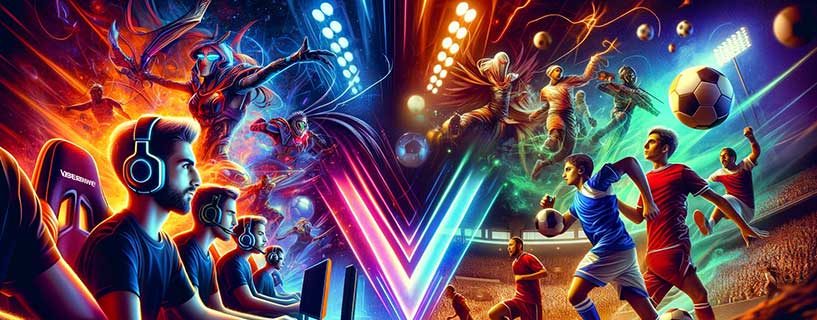In recent years, the world of sports has witnessed a seismic shift with the rise of esports. Once considered a niche interest, esports has evolved into a global phenomenon, challenging the dominance of traditional sports in unprecedented ways. This article delves into the profound impact of esports on traditional sports, exploring the intersection of these two seemingly disparate worlds and the implications for athletes, fans, and stakeholders alike.
Introduction to Esports
Esports, short for electronic sports, refers to competitive video gaming facilitated by electronic systems. It involves players competing against each other in various video game titles, often in organized tournaments with substantial prize pools. What started as casual gaming among friends has transformed into a multi-billion-dollar industry with a dedicated fan base and professional leagues.
Rise of Esports Globally
Growth Statistics
Esports has experienced exponential growth, transcending geographical and cultural boundaries. According to industry reports, the global esports market revenue is projected to exceed $1.5 billion by [2024], with a year-over-year growth rate surpassing traditional sports.
Popular Esports Games
Games like League of Legends, Dota 2, and Counter-Strike: Global Offensive have become household names, attracting millions of players and spectators worldwide. The competitive nature and accessibility of these games have contributed to their widespread popularity and success.
Traditional Sports in the Modern Era
While traditional sports have long been the cornerstone of athletic competition, they have faced challenges adapting to the digital age. The emergence of streaming platforms, social media, and on-demand content has transformed how audiences consume sports, prompting traditional sports leagues to innovate and evolve.
The Intersection of Esports and Traditional Sports
Similarities and Differences
Despite their differences in format and presentation, esports and traditional sports share common ground in their competitive nature and ability to captivate audiences. Both involve skilled athletes striving for victory while entertaining spectators.
Collaboration Opportunities
Recognizing the potential synergies between esports and traditional sports, many organizations have begun exploring collaborative initiatives. From sponsorships and endorsements to cross-promotional events, these partnerships aim to leverage the strengths of both worlds to enhance fan engagement and drive revenue.
Impact on Audience Engagement
Changing Demographics
One of the most significant impacts of esports on traditional sports is the shifting demographics of the fan base. Esports appeals to a younger and more diverse audience, including digital natives who have grown up in an era dominated by technology.
Shift in Viewing Patterns
Esports has also reshaped how audiences consume sports content. With the rise of streaming platforms like Twitch and YouTube Gaming, fans can watch live tournaments and matches from the comfort of their homes, eliminating the need for traditional broadcast channels.
Economic Influence
Revenue Generation
The economic influence of esports extends beyond ticket sales and merchandise to include sponsorships, advertising, and media rights. Brands eager to reach the coveted esports demographic are investing heavily in partnerships and activations, driving revenue growth for both esports organizations and traditional sports leagues.
Investment Trends
Venture capitalists and private equity firms have taken notice of the lucrative opportunities in esports, pouring millions of dollars into team ownership, tournament organizers, and technology startups. This influx of capital has fueled further growth and innovation within the industry.
Technological Advancements
Virtual Reality and Augmented Reality
Technological advancements like virtual reality (VR) and augmented reality (AR) are revolutionizing the fan experience in both esports and traditional sports. VR simulations allow fans to immerse themselves in the action, while AR overlays provide real-time stats and insights during live events.
Broadcasting Innovations
Broadcasting esports tournaments require specialized production techniques to capture fast-paced action and dynamic gameplay. From customizable camera angles to interactive overlays, broadcasters are continually pushing the boundaries of what is possible in esports coverage.
Challenges and Opportunities
Acceptance from Traditional Sports Entities
While esports continues to gain mainstream acceptance, there are still barriers to overcome, particularly from traditional sports entities wary of the competition. Some view esports as a threat to their existing fan base and revenue streams, while others see it as an opportunity for growth and diversification.
Overcoming Stereotypes
Esports enthusiasts often face stereotypes and misconceptions about their hobby, ranging from concerns about screen time and sedentary lifestyles to scepticism about its legitimacy as a sport. Educating the public and debunking these myths is essential for fostering greater acceptance and understanding.
Future Outlook
Potential Growth Areas
As technology continues to evolve and audiences demand more immersive experiences, the future of esports looks promising. From mobile gaming to esports betting, numerous growth areas are waiting to be explored, offering opportunities for innovation and expansion.
Evolving Fan Experiences
The convergence of esports and traditional sports is leading to innovative fan experiences that blur the lines between the physical and digital worlds. Whether through virtual fan zones, interactive broadcasts, or augmented reality activations, the future of sports entertainment is bound to be exciting and dynamic.
The impact of esports on traditional sports is undeniable, ushering in a new era of competition, innovation, and collaboration. As these two worlds continue to intersect and evolve, the opportunities for athletes, fans, and stakeholders are limitless. Embracing this convergence and harnessing the power of technology will be key to shaping the future of sports entertainment.
FAQs
- Are esports considered real sports? Esports may not involve physical exertion in the traditional sense, but they require skill, strategy, and teamwork, much like traditional sports.
- How do traditional sports benefit from partnering with esports? Traditional sports organizations can tap into the growing esports audience, diversify revenue streams, and enhance fan engagement through collaborative initiatives.
- What challenges do esports face in gaining mainstream acceptance? Esports still face stereotypes and misconceptions about their legitimacy and impact, which can hinder acceptance from traditional sports entities and the broader public.
- What role does technology play in the convergence of esports and traditional sports? Technology enables immersive fan experiences, innovative broadcasting techniques, and new revenue opportunities, driving the convergence of esports and traditional sports.
-
What does the future hold for esports and traditional sports? The future is bright for both industries, with continued growth, innovation, and collaboration on the horizon, creating exciting opportunities for athletes, fans, and stakeholders alike.






